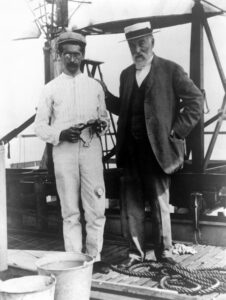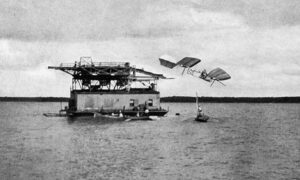7 October 1903 – “Samuel Pierpont Langley conducts the first tests of his full-sized man-carrying version of his earlier model aerodromes. The pilot, Charles Manly, nearly drowns when the machine slides off its launch apparatus atop a houseboat and falls into the Potomac River.

Langley, right, with test pilot Charles Manly
Langley attempted to make a working piloted heavier-than-air aircraft. His models flew, but his two attempts at piloted flight were not successful. Langley began experimenting with rubber-band-powered models and gliders in 1887. (According to one book, he was not able to reproduce Alphonse Pénaud’s time aloft with rubber power but persisted anyway.) He built a rotating arm (functioning as a wind tunnel) and made larger flying models powered by miniature steam engines. Langley realized that sustained powered flight was possible when he found that a 1 lb. brass plate suspended from the rotating arm by a spring, could be kept aloft by spring tension of less than 1 oz.
Langley understood that aircraft need thrust to overcome drag from forward speed, observed higher aspect ratio flat plates had higher lift and lower drag, and stated in 1902 “A plane of fixed size and weight would need less propulsive power the faster it flew”, the counter-intuitive effect of induced drag.
His first success came on May 6, 1896, when his Number 5 unpiloted model weighing 25 pounds (11 kg) made two flights of 2,300 ft (700 m) and 3,300 ft (1,000 m) after a catapult launch from a boat on the Potomac River. The distance was ten times longer than any previous experiment with a heavier-than-air flying machine, demonstrating that stability and sufficient lift could be achieved in such craft.
On November 11 that year his Number 6 model flew more than 5,000 feet (1,500 m). In 1898, based on the success of his models, Langley received a War Department grant of $50,000 and $20,000 from the Smithsonian to develop a piloted airplane, which he called an “Aerodrome” (coined from Greek words roughly translated as “air runner”). Langley hired Charles M. Manly (1876–1927) as an engineer and test pilot. When Langley received word from his friend Octave Chanute of the Wright brothers’ success with their 1902 glider, he attempted to meet the Wrights, but they politely evaded his request.
While the full-scale Aerodrome was being designed and built, the internal combustion engine was contracted out to manufacturer Stephen M. Balzer (1864–1940). When he failed to produce an engine to the power and weight specifications, Manly finished the design. This engine had far more power than did the engine for the Wright brothers’ first airplane—50 hp compared to 12 hp. The engine, mostly the technical work of men other than Langley, was probably the project’s main contribution to aviation.[13] The piloted machine had wire-braced tandem wings (one behind the other). It had a Pénaud tail for pitch and yaw control but no roll control, depending instead on the dihedral angle of the wings, as did the models, for maintaining roughly level flight.

In contrast to the Wright brothers’ design of a controllable airplane that could fly with assistance from a strong headwind and land on solid ground, Langley sought safety by practicing in calm air over the Potomac River. This required a catapult for launching. The craft had no landing gear, the plan being to descend into the water after demonstrating flight which if successful would entail a partial, if not total, rebuilding of the machine. Langley gave up the project after two crashes on take-off on October 7 and December 8, 1903.” (1)
(1) Wikipedia
